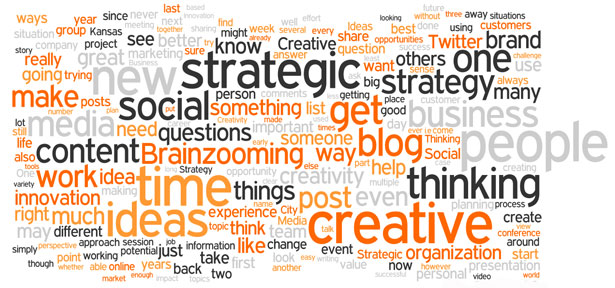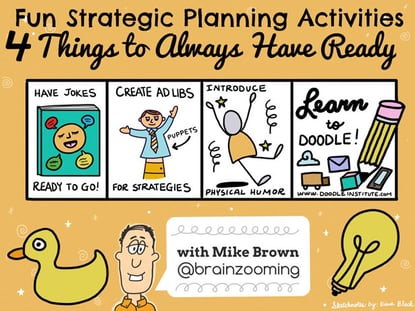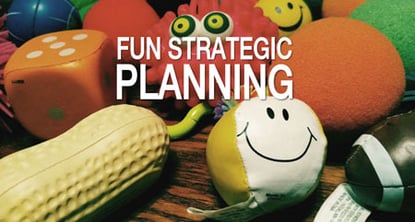There are many factors that go into productive strategic thinking exercises and efficient group strategy development sessions. Here is an A to Z recap of some of what goes into how Brainzooming approaches strategy development:
Appreciative Inquiry - Incorporate positive questions focused around when a group is at its strategic best.
Balance - The best strategic thinking emerges when you have diverse people with a balance of thinking perspectives coupled with strategic exercises allowing them to work together productively.
Crowdsourcing - Include perspectives even from people not involved directly in strategic planning or setting strategy.
Design - Strategic thinking and conversations are more productive when they are anticipated ahead of time; we design collaboration experiences to lead productive conversations where they need to go.
Energy - Facilitators have to introduce energy into strategic conversations to spur them to be wider, deeper, and bolder than they might otherwise be.
Fun - Mental variety, easy-to-participate exercises, humor, and toys all make what can be the drudgery of almost all strategic planning into an enjoyable, fun experience.
Group – Using small groups is typically a very efficient way to vary the working interactions within a strategic thinking session and maximize the number of people contributing ideas.
Homework – To maximize a group’s efficiency, use homework prior to the session to gather information and other inputs that don’t demand or benefit from creative group interaction.
Insights - Strategic thinking is most productive when based on robust insights about an organization's markets, environment, and important objectives.
Jokes - There are very strong comparisons between the pattern for innovation and the pattern for something being funny, so using humor helps to get the innovation going.
Kudos - Throughout time a group spends on strategic thinking, it's important to recognize and celebrate the group for its progress.
Limits – Setting time limits for how long a group spends on any one strategic thinking exercise before moving to another creates opportunities to look at situations from many different perspectives more efficiently.
Movement - One reason for recording ideas - whether on paper or electronically - is to allow you to make them portable and bring them closer to or further away from others ideas to create new concepts.
Numbers – Creativity and innovation are numbers games. The more ideas you generate, the greater the probability you’ll arrive at on-target answers to address your strategic opportunity.
Openness - An open conversation starts with having an open space for the conversation to take place so both people and ideas have an opportunity to move in and move away as needed.
Prioritization - While it may be confined to certain times or phases, it's important to use the knowledge and expertise of the people imagining strategic possibilities to also provide input on the most attractive ones.
Questions - People genuinely try to answer robust questions tailored to their knowledge and expertise when they are asked them during a strategy session.
Rules – Establishing general rules for a strategic thinking collaboration lets participants know upfront how the group will interact and the expectations for collaboration.
Serving - Facilitators have to have an attitude of serving the participants with a focus on helping them achieve their strategic objectives from a session.
Thinking – While taking action is the ultimate goal in developing strategy, the initial and ongoing time you spend on strategic thinking is critical to productive strategy formulation.
Unexpected - Strategic questions and exercises should take participants into new areas or help them see old areas in very new and different ways they hadn't previously imagined.
Volume - The best thinking emerges from considering many different possible strategic situations, which leads to a much larger number of ideas to choose from when it's appropriate to do so.
Waiting – As much as you may want strategic thinking to move ahead more quickly, it is important to be able to embrace waiting for new strategic ideas to emerge from a group’s interaction.
X-axis - Along with the y-axis, graphing strategic relationships helps participants imagine marketplace relationships and opportunities.
Yield - The best strategic thinking exercises are tried, tested, and tweaked to produce a sufficient number of new ideas and answers in an efficient fashion.
Zero - The value of having a very small, homogenous group as the only group to focus on strategy. – Mike Brown





